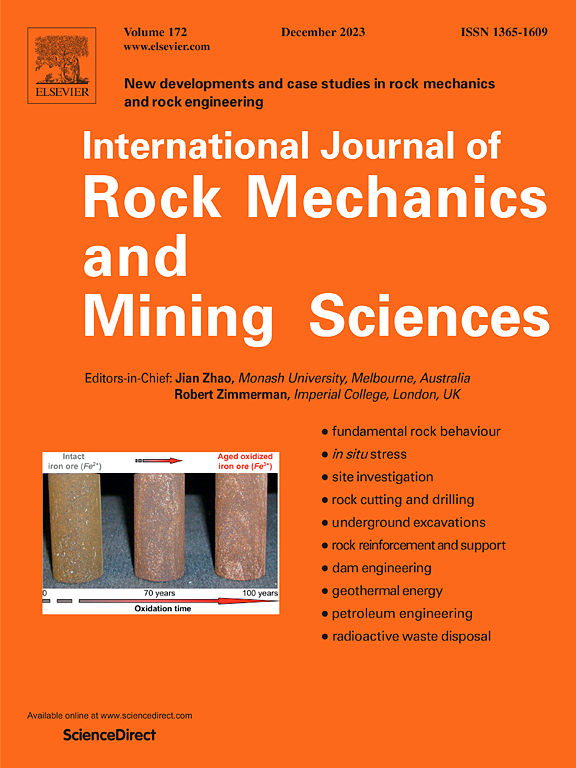A novel method for evaluating stability and mechanism of flexural toppling based on energy conservation principle and numerical simulation
IF 7
1区 工程技术
Q1 ENGINEERING, GEOLOGICAL
International Journal of Rock Mechanics and Mining Sciences
Pub Date : 2024-09-21
DOI:10.1016/j.ijrmms.2024.105896
引用次数: 0
Abstract
The flexural toppling occurring in anti-dip layered slopes exhibits complex mechanical behaviours and poses a serious threat to human engineering practices. In this paper, a novel method for evaluating the stability of flexural toppling is proposed by combining analytical solution and numerical simulation. The anti-dip rock layers in the slope are regarded as inclined slabs, and the deflection equations of each rock slab are calculated when the slab at the basal plane is restrict and that at the top is free. Critical length of the rock slab is then determined with the energy conservation principle, and it can be employed to evaluate the stability of flexural toppling. Numerical simulations have been conducted to validate the present calculation method and explore the mechanisms of flexural toppling. The simulation results indicate that failure initially occurs at the slope toe due to strong stress concentration, subsequently triggering a domino effect with failures propagate to the upper rock slabs as a result of the loss of support from the lower ones. These simulation results also combined with the analytical solution enhance the calculation accuracy of the method. This innovative approach not only advances our understanding of flexural toppling mechanisms but also provides a method for practical stability assessments.
基于能量守恒原理和数值模拟的新型挠性倾覆稳定性和机理评估方法
抗倾覆层状斜坡发生的挠曲倾覆表现出复杂的力学行为,对人类工程实践构成严重威胁。本文通过分析求解和数值模拟相结合的方法,提出了一种新型的挠曲倾覆稳定性评估方法。将斜坡中的抗倾覆岩层视为倾斜岩板,计算基面岩板受限和顶面岩板自由时每块岩板的挠度方程。然后根据能量守恒原理确定岩板的临界长度,并可用于评估挠曲倾覆的稳定性。为了验证本计算方法并探索挠曲倾覆的机理,我们进行了数值模拟。模拟结果表明,由于应力高度集中,崩塌最初发生在坡脚,随后引发多米诺骨牌效应,由于下部岩板失去支撑,崩塌向上部岩板蔓延。这些模拟结果与分析解决方案相结合,提高了该方法的计算精度。这种创新方法不仅加深了我们对挠性倾覆机制的理解,还为实际稳定性评估提供了一种方法。
本文章由计算机程序翻译,如有差异,请以英文原文为准。
求助全文
约1分钟内获得全文
求助全文
来源期刊
CiteScore
14.00
自引率
5.60%
发文量
196
审稿时长
18 weeks
期刊介绍:
The International Journal of Rock Mechanics and Mining Sciences focuses on original research, new developments, site measurements, and case studies within the fields of rock mechanics and rock engineering. Serving as an international platform, it showcases high-quality papers addressing rock mechanics and the application of its principles and techniques in mining and civil engineering projects situated on or within rock masses. These projects encompass a wide range, including slopes, open-pit mines, quarries, shafts, tunnels, caverns, underground mines, metro systems, dams, hydro-electric stations, geothermal energy, petroleum engineering, and radioactive waste disposal. The journal welcomes submissions on various topics, with particular interest in theoretical advancements, analytical and numerical methods, rock testing, site investigation, and case studies.

 求助内容:
求助内容: 应助结果提醒方式:
应助结果提醒方式:


